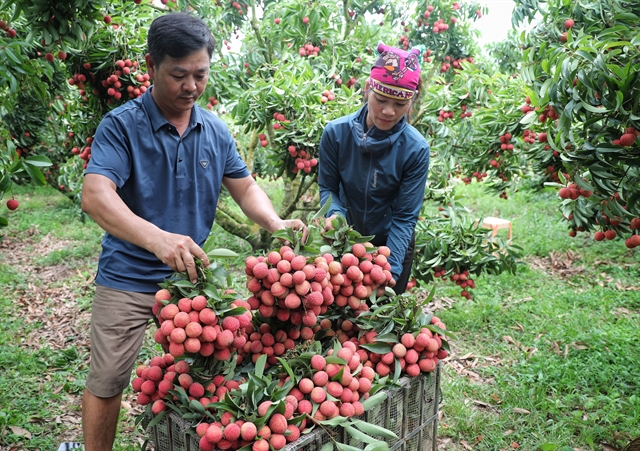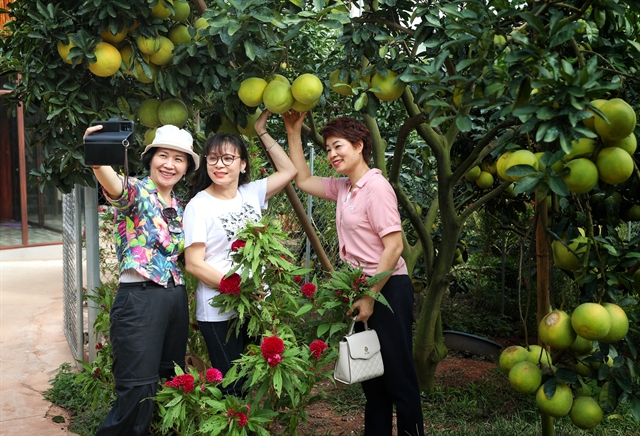 Society
Society

HÀ NỘI — Bắc Giang is a province in the Northeast region of Việt Nam, about 50 km from Hà Nội. The province is located on the economic corridor Hà Nội – Hải Phòng – Lạng Sơn – Nanning (China), adjacent to the critical economic region of the North.
With diverse terrain, Bắc Giang has favourable soil conditions to develop biodiverse agriculture, including many crops of high economic value.

|
| Harvesting lychees in Phương Sơn commune, Lục Ngạn district, Bắc Giang province. VNS Photo |
Mr. Dương Thanh Tùng, Director of Bắc Giang Department of Agriculture and Rural Development, said that in the coming time, the province will continue to restructure production to enhance the value of the agriculture sector.
The province strictly protects the growing areas for double-crop rice to ensure food security, manages and uses rice-growing land effectively, and flexibly switches between growing food crops and fruit trees.
In addition, Bắc Giang continues to review and adjust planning and plans to transform crop production structure by advantages and market needs, adapting to climate change. Bắc Giang will also continue to revise and amend the "Digital map of concentrated production areas of key agricultural products and high-tech agricultural production areas in Bắc Giang province" to comply with the Bắc Giang Provincial Planning for the period 2021 - 2030, which was approved by the Prime Minister.
From now to 2030, Bắc Giang will restructure the farming sector by reducing the proportion of food crop production value and increasing the ratio of fruit trees, vegetables, industrial crops and quality rice to meet the consumer market demand and ensure food security.
The province strives to increase the production value of the crop sector (according to 2010 comparative prices) at 2.6%/year. By 2030, agricultural land/ hectare production will reach VNĐ155 million.
The province keeps the rice area stable to ensure food security. By 2030, the area of rice cultivation land will be about 48,748 hectares. By 2050, the area of double-crop rice land that needs strict protection will be about 38,000 hectares to ensure food security.
According to Tùng, from now until 2030, Bắc Giang will focus on developing concentrated, large-scale agricultural production areas and organising chain production for key products. At the same time, the province encourages the development of clean, organic, and high-tech agriculture to meet market needs and serve tourism.

|
| A grapefruit garden in Thanh Hải commune, Lục Ngạn district. VNS Photo |
The province promotes the development of planting, processing, consumption and building a collective brand of advantageous indigenous medicinal plants, such as purple morinda officinalis, golden camellia, and Dành mountain ginseng, on forested hill land in Sơn Động, Lục Ngạn, Lục Nam, Yên Thế and Tân Yên districts.
Additionally, Bắc Giang supports the construction, issuance and management of growing area codes for main crops, including vegetables and fruit trees, especially crops with export potential of over 50,000 hectares. The province supports the construction of preliminary processing, packaging, product processing facilities and agricultural product storage systems to meet the technical requirements of exporting enterprises and markets of importing countries.
From 2021 up to now, Bac Giang has firmly converted the area of unstable single-crop rice and the area of fruit trees with low economic efficiency to areas of vegetables and fruit trees with higher economic value. Additionally, Bac Giang is interested in developing key, speciality and potential crops of the province, such as lychee, longan, custard apple, orange, grapefruit, apple and star apple. The province implements planning of large-scale concentrated production areas, promoting the application of technical advances and production according to VietGAP and GlobalGAP organic safety processes associated with consumer markets and brand development.
Crops grown in the province are produced safely and are granted brand protection certificates, ensuring fruit quality to meet the increasing demands of consumers and export markets. Of these, the rate of intensive vegetable production according to VietGAP standards is estimated at 56%; the rate of intensive fruit tree production according to VietGAP standards is estimated at 53%.
Lưu Anh Đức, Head of the Department of Agriculture and Rural Development of Lục Ngạn district, said: "The locality has implemented synchronously, from planning and organising large-scale concentrated commodity production areas to choosing to develop advantageous products and applying technical advances to production to improve productivity and quality.
To have fruit production areas that meet export conditions of demanding markets such as Japan, Europe and the United States, the district specialists have accompanied farmers in propaganda and technical guidance events, monitoring the use of pesticides and pest control."
Nguyễn Văn Hữu, a farmer from Xẻ Cũ village, Thanh Hải commune, Lục Ngạn district, said: "The family's green-skinned grapefruit garden is grown organically so it is always green and produces beautiful, quality and delicious grapefruit. My family's farm has the district's largest green-skinned grapefruit growing area, with 5,000-6,000 orange trees and about 2,000 green-skinned grapefruit trees within 10 hectares." VNS




